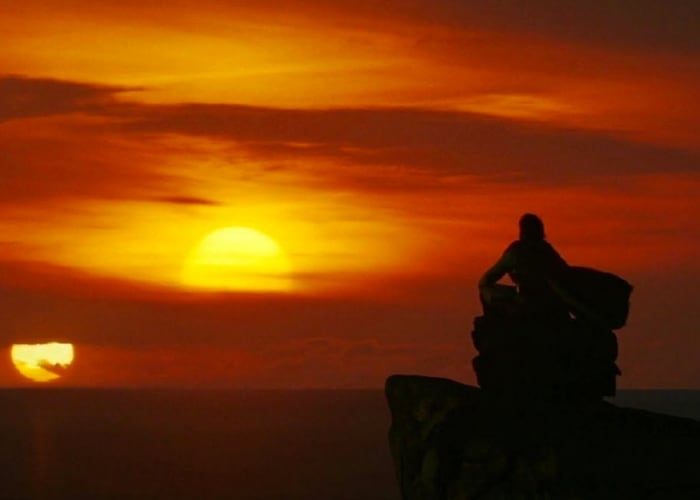One of the most maligned decisions ever made in the Star Wars franchise was the Prequels’ introduction of midi-chlorians, microscopic organisms that basically determine, through genetics, an individual’s ability to use the Force. Everyone hated this, understandably. Part of the appeal of the Force was always its mysticism. Midi-chlorians turned something spiritual into something scientific, and in doing so drained the drama right out of a drama-based plot element.
The Star Wars sequel trilogy, particularly The Last Jedi, dramatically backpedals on this decision. In Rey’s training, Luke explicitly and overtly re-explains the Force in the same terms that Obi-Wan did way back in A New Hope. The Force is… well, it’s a force, a sort of spiritual intrinsic field that connects all life, always in balance. Fittingly, one of the most distinct pieces of imagery in The Last Jedi is the enormous mosaic of the Prime Jedi symbol, which bears a distinct resemblance to the yin-yang symbol.
About a year after seeing The Last Jedi, I returned to China to visit family, who took me to the Hangu Pass (函谷关), which is supposedly where Laozi (老子), the founder of spiritual Taoism, wrote the Tao Te Ching (道德经), which is basically the Taoist Bible (the historical accuracy of this fact is debatable, due to the text’s sheer age). It struck me just how similar the concept of the Force is to Taoism. Besides a courtyard that features a similar giant yin-yang mosaic, the site features a number of quotes on tablets attributed to Laozi that, when translated to English, read like something straight out of Star Wars.
The concept of the “tao” (道) is near identical to the Force. Roughly translated, it means something like “way,” “path,” or “road,” but in Taoism it is used to refer to a spiritual “flow of the universe” that all things are a part of. Much like the Force, all living things are part of the Tao, and vice-versa. The oft-misunderstood concept of yin-yang is also vitally important to Taoism. But unlike in Star Wars, where the Light side and Dark side are often simplified to a good-versus-evil binary, yin and yang are more representative of balance. Yin and yang are two opposing but complementary existences, of which one cannot exist without the other. Indeed, according to Taoist metaphysics, the dichotomy of good and evil, is, in fact, nonexistent, as the dichotomy itself is one whole.
The often forgotten scene in Star Wars that illustrates how balance is important between the two sides of the Force is right near the end of Return of the Jedi, when Luke uses — but, crucially, does not give in to — his anger in his fight with Darth Vader. He taps into but does not succumb to the Dark side. At this moment, he does not subscribe to the Light side zealotry that Yoda demanded of him and the Jedi Order demanded of Anakin in the prequel trilogy. In the Taoist view of the Force, this “Light side only” approach taken by the Order, which asks its acolytes to discard all emotion, is just as flawed as Palpatine’s power-hungry Dark side methods. Their hard-line stance is just as much to blame for the creation of Darth Vader as the Emperor’s manipulations. Luke’s final battle against Vader shows him taking a balanced approach to the Force. The power of emotion becomes tempered by discipline, giving Luke far greater strength than if he had relied on only one or the other. Luke embraces not one part or the other of the dichotomy, but the whole of the Force. All things in balance.
Taoist ethics is further littered with these sort of existential oxymorons, the most notable of which is “wu wei” (无为), roughly translated as “effortless action” or “action without intent.” The key concept here is harmony with the Tao and the natural order of things. Taoist ethics warns that anyone who attempts to exert their will outside of the natural cycles of the universe (i.e., the Tao) will disrupt that flow. Water, specifically flowing water, is frequently used as an example; streams and rivers fluidly move around obstacles, allowing natural obstacles and the lay of the land to guide them, without forcing those obstacles to bend to their will. To bring things back to Star Wars, Luke says something similar when he tells Rey “[the Force] does not belong to the Jedi.” According to his assertions, he has violated wu wei and must pay penance by cutting himself off from the Force.
As such, The Last Jedi stands as the Star Wars film with the most interest in the spiritual Taoist roots of the concept of the Force, where almost every other film has relied on the played-out good versus evil dichotomy of the Light and Dark sides. Taoism provides a neat and tidy real-world framework for understanding the Force, even if the parallels aren’t quite one-to-one. Ultimately, the Force is the most interesting when it’s more spiritual and less science, and drawing connections to Taoism allows the filmmakers to add depth to this vital plot element without resorting to midi-chlorians.

